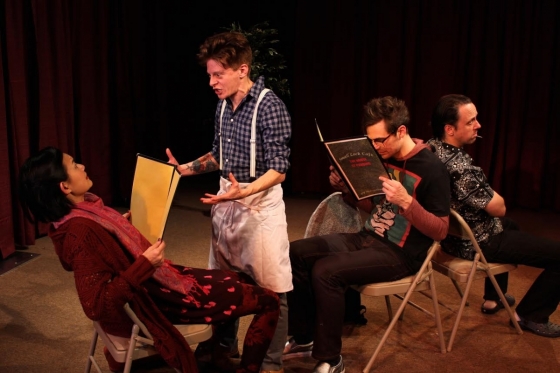
It may be reductive to say that Trish Harnetiaux's new postmodern comedy is about love and relationships, but it's the easiest way to begin. How to Get into Buildings is in some ways a play about itself, thick with meta-theatrical moments. In other ways, it is as if Samuel Beckett directed Magnolia. Harnetiaux cites her structural inspiration as exploded-view diagrams and their arrangement of parts in relationship but not in contact with each other, perhaps echoed in one character's predilection for bento boxes.The main components of this particular diagram are two couples, one of which represents the discrete parts coming together, and the other those parts moving apart: Lucy Maserati (Kristine Haruna Lee) and Roger Sauvignon (Jacob A. Ware), and Daphne Pierre-Pont (Stephanie Weeks) and Nick Nova-Scotia (Mike Iveson), the former pair experiencing the first blush of a relationship's inception and the latter resentfully waiting out its inevitable dissolution. Silver Surfer fan and aspiring motivational speaker Roger meets Lucy outside a convention center, where he is attending Comic-Con. Lucy, meanwhile, holds periodic phone conversations with the enigmatic Mrs. Rhinehardt (Tina Shepherd), who evinces the wisdom of a metaphysical sage and the monthly fee structure of a televangelist. Fiery Daphne and sullen Nick primarily snipe at one another across a diner table while attended, hilariously, by the Waiter (Jess Barbagallo).
Also at the center of the play is a book, (perhaps, or sometimes) by Ethan Cambabert (also Jess Barbagallo, and maybe also the Waiter) called The Car Accident, except when it is called The Shootout, but lines between book, reality (within the world of the play), and the play itself are all very slippery. In How to Get into Buildings, boundaries -- of narrative, chronology, and identity -- fall somewhere between fuzzy and fluid. The performers even step over an invisible boundary to get on stage, and the play itself spills subtly beyond the bounds of the house doors and start time in a way that the audience only eventually becomes aware of. The piece engages in the kind of indeterminacy that says that a flipped coin can be both heads at tails at the same time as long as no one looks at it. A consistent return to the metaphor of the curve relates significantly to this playing with the indeterminate. Curves come to symbolize chance, the unforeseen, the accidental, building their resonance from a curve in the road that causes a car accident that spills a shipment of red snapper across the pavement, forcing the Waiter to apologize for its absence from the kitchen even as customers are choosing between waffles and omelets. This emphasis on the unexpected is also reflected in the interruptions of characters while they are speaking, as they are occasionally bumped into by others or competed with by music.
How to Get into Buildings features a good deal of heightened language and exaggeration, and characters often speak aloud their unfiltered thoughts, inner monologues, or meta-commentary on themselves. This feature allows for some great moments of character observation, and the hefty doses of absurdism remain grounded in recognizable, relatable relationships, thanks in no small part to the actors; Lucy and Roger fall awkwardly and appealingly in love with each other, while Daphne and Nick act out a not-uncommon fantasy of giving a definitive end to a break-up. Jess Barbagallo is extremely funny in his several roles and is clearly having a great time, which translates to the audience. Finally, the impressive staging of the play's climax and its overlapping dialogue deserves special mention.
Produced by New Georges, a company focused on plays by "theatrically adventurous" women artists, How to Get into Buildings is perhaps better experienced than explained. Suffice to say that Trish Harnetiaux's experimental new work is a wild, wildly fun ride. As Lucy says about The Car Accident, "It's like time travel and true love and shootouts. I don't want to give anything away... The only thing I'll says is that it's really important to just keep reading it. Even if at first you think it's not for you. It is. It's exactly for you." - Leah Richards & John Ziegler
